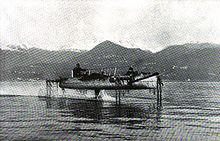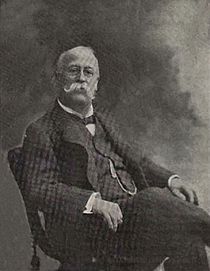Enrico Forlanini - Picture
More Aviation History

|
|
Enrico Forlanini

Picture - Enrico Forlanini.
Enrico Forlanini (December 13, 1848 - October 9, 1930) was an Italian engineer, inventor and aeronautical pioneer, well known for his works on helicopters, aircraft, hydrofoils and dirigibles. He was born in Milan. His older brother Carlo Forlanini was a famous Italian physician (1847-1918).
Early life
Enrico was born to Francesco Forlanini, a notable physician and director of the Ospedale Fatebenefratelli in Milan. After elementary school he attended one of the three Milan Regie Scuole Tecniche, in 1863 he entered the military college of Turin, to pass to its military academy in 1866. Two years later he passed to the Scuola di Applicazione Artiglieria e Genio where he graduated with a diploma in 1870.
Helicopter model
In 1877, he developed an early helicopter powered by a steam engine. It was the first of its type that rose to a height of 13 meters, where it remained for some 20 seconds, after a vertical take-off from a park in Milan.
Industry
Then, he worked in Forlx¬, in a society named Societx Anonima Forlivese per l’illuminazione a gas e per la fonderia di ferro.
Airships
Later he designed and built a series of dirigibles, notably, designed in 1901 and launched in 1909, the Leonardo da Vinci that he dedicated to the famous Renaissance inventor and, in 1912, the Cittx di Milano, dedicated to his beloved home town. The latter showed exceptionally good characteristics of stability and controllability that won Forlanini international renown. A further four airships were constructed: F3, F4, F5 and F6. A seventh, named Omnia Dir was only completed after his death and never flew.
Hydrofoils

Picture - Forlanini hydrofoil on Lake Maggiore circa 1911
He is also known for his hydrofoils that he started modelling since 1898. One of those, built at full scale, used a ladder system of foils and a 60 hp (45 kW) engine driving two counter-rotating air props. During testing on Lake Maggiore in 1906, this craft reached a top speed of 68 km/h (42.5 mph). He also tested a hydrofoil with a 25 horsepower (19 kW) steam engine but this only achieved around 50 kilometres per hour (31 mph) in 1908-1909.
Legacy
Forlanini obtained a number of British and American patents on his ideas and designs, most of which were aimed at seaplane applications.
He died in 1930 while still working on the design of the Omnia Dir airship.
Milan has dedicated to him its city airport, also named Linate Airport, as well as the nearby park.
Diego Brozzola. 1999. Aerei Italiani - "Il mio Idroplano" dell'Ing Enrico Forlanini (Italian) last accessed 2008-06-30
Gian Luca Lapini. 2004. Storia di Milano ::: Enrico Forlanini (Italian) last accessed 2008-06-30
OFFICINE LEONARDO DA VINCI THE HISTORY - Enrico Formanini and the Officine Leonardo da Vinci
The New York Times Magazine. 1918-01-13 Page SM3. New Italian Airship Better Than Zeppelin, last accessed 2008-06-30 (full article)
Enrico Forlanini Pictures
More aircraft.
Source: WikiPedia